
A rajkulo (English: royal canal) is a type of canal found in Nepal. It provides water for Irrigation, dhunge dharas, and ponds, and it can be dated back to the Lichhavi era. [1] [2]

A rajkulo (English: royal canal) is a type of canal found in Nepal. It provides water for Irrigation, dhunge dharas, and ponds, and it can be dated back to the Lichhavi era. [1] [2]

Kathmandu, officially Kathmandu Metropolitan City, is the capital and most populous city of Nepal with 845,767 inhabitants living in 105,649 households as of the 2021 Nepal census and approximately 4 million people in its urban agglomeration. It is located in the Kathmandu Valley, a large valley in the high plateaus in central Nepal, at an altitude of 1,400 metres.
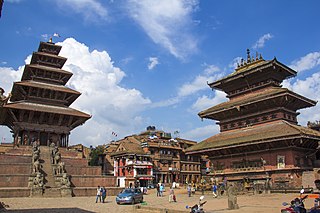
Bhaktapur, known locally as Khwopa and historically called Bhadgaon, is a city in the east corner of the Kathmandu Valley in Nepal located about 13 kilometres (8.1 mi) from the capital city, Kathmandu. Bhaktapur is the smallest city of Nepal as well the most densely populated. Along with Kathmandu and Lalitpur, Bhaktapur is one of the three main cities of the Kathmandu Valley and is a major Newar settlement of the country. The city is also known for its Newar tradition, cuisine and artisans. Bhaktapur suffered heavy damage in the April 2015 earthquake.
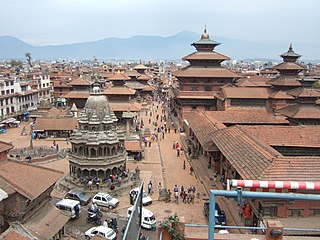
Lalitpur Metropolitan City is a metropolitan city and fourth most populous city of Nepal with 299,843 inhabitants living in 49,044 households per the 2021 census. It is located in the south-central part of Kathmandu Valley, a large valley in the high plateaus in central Nepal, at an altitude of 1,400 metres.

A drinking fountain, also called a water fountain or water bubbler, is a fountain designed to provide drinking water. It consists of a basin with either continuously running water or a tap. The drinker bends down to the stream of water and swallows water directly from the stream. Modern indoor drinking fountains may incorporate filters to remove impurities from the water and chillers to lower its temperature. Drinking fountains are usually found in public places, like schools, rest areas, libraries, and grocery stores.

The culture of Nepal encompasses the various cultures belonging to the 125 distinct ethnic groups present in Nepal. The culture of Nepal is expressed through music and dance; art and craft; folklore; languages and literature; philosophy and religion; festivals and celebration; foods and drinks.

The Kathmandu Valley, also known as the Nepal Valley or Nepa Valley, National Capital Area, is a bowl-shaped valley located in the Himalayan mountains of Nepal. It lies at the crossroads of ancient civilizations of the Indian subcontinent and the broader Asian continent, and has at least 130 important monuments, including several pilgrimage sites for Hindus and Buddhists. There are seven World Heritage Sites within the valley.

Bhaktapur District (Nepali: भक्तपुर जिल्ला; Nepal Bhasa : ख्वप देश located in the eastern part of Kathmandu valley, is the smallest district among the seventy-seven districts of Nepal. It is part of Bagmati Province. Bhaktapur District Post Office is 44800. The district, with Bhaktapur as its district headquarters, covers an area of 119 km2 and in 2011 had a population of 304,651 of whom 9,701 people were absent.
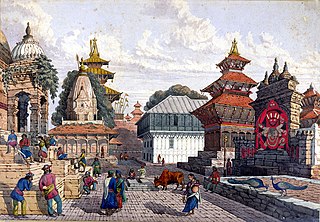
The Malla dynasty was the ruling dynasty of the Kathmandu Valley in Nepal from 1201 to 1779. This dynasty was founded by Arideva Malla. Though latter Mallas were regarded as belonging to the Raghuvamsha dynasty, they were also seen as continuation and descendants of the Licchavi dynasty. Later Malla kings also traced one section of their lineage from Nanyadeva, the founder of the Karnat dynasty of Mithila. The term malla means wrestler in Sanskrit. The first use of the word malla in the Kathmandu Valley begins from 1201.

A dhunge dhara or hiti is a traditional stone drinking fountain found in Nepal. It is an intricately carved stone waterway through which water flows uninterrupted from underground sources. Dhunge dharas are part of a comprehensive drinking water supply system, commissioned by various rulers of Ancient and Medieval Nepal. The system is supported by numerous ponds and canals that form an elaborate network of water bodies, created as a water resource during the dry season and to help alleviate the water pressure caused by the monsoon rains. After the introduction of modern, piped water systems, starting in the late 19th century, this old system has fallen into disrepair and some parts of it are lost forever. Nevertheless, many people of Nepal still rely on the old dhunge dharas on a daily basis.
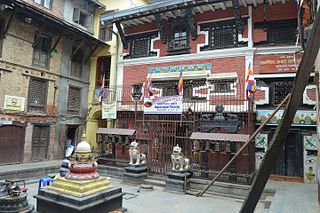
Guthi or Gosthi is a social system of the Newar people in Nepal. With land trusts, Guthis support the socio-economic status of their communities. The land held by Guthis is used for various projects and to generate revenue. The system began around the 5th century B.C., and most Guthis are now either defunct or a vestigial representation of their former role. In 2019, the Guthi bill—which proposed nationalizing all Guthis—was withdrawn following protests by Newars in Kathmandu Valley.

Durbar Square or royal Squares in English, is the generic name that refers to the plazas and areas opposite the old royal palaces in Nepal. The name comes from Persian دربار (Darbar). The durbar squares are full of temples, idols, open courts, water fountains and much more. Before the Unification of Nepal, Nepal consisted of smaller independent kingdoms, and Durbar Squares are some prominent remnants of those old kingdoms in Nepal. There are three Durbar Squares in the Kathmandu Valley, belonging to the three Newar kingdoms who were situated there before unification, are most famous: Kathmandu Durbar Square, Patan Durbar Square, and Bhaktapur Durbar Square. All three of these landmarks are UNESCO World Heritage Sites.These sites had received significant damage due to the devastating earthquake of 2015 but most structures still remain or were reconstructed.

Rani Pokhari, originally known as Nhu Pukhu, is a historic artificial pond located in the heart of Kathmandu, Nepal. The square-shaped tank dates from the 17th century, and was built on the eastern side of the then city limits. It lies just outside a former city gate. The pond is one of Kathmandu's most famous landmarks and is known for its religious and aesthetic significance. Its dimensions are 180m by 140m.
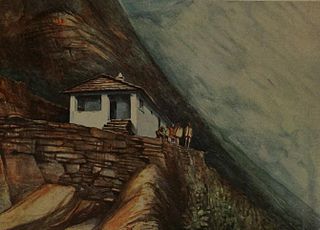
A dharamshala, also written as dharmashala, is a public resthouse or shelter in the Indian subcontinent. It also refers to Sikh places of worship before the introduction of Gurdwaras. Just as sarai are for travellers and caravans, dharamshalas are built for religious travellers at pilgrimage sites. In Nepal there are dharamshalas especially built for pilgrims as well as dharamshalas for locals.
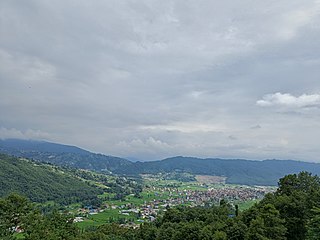
Sankhu is the ancient Newar town located in the north-eastern corner of Kathmandu Valley which is about 17 km from the city center of Kathmandu. Sankhu was formerly divided into three Village Development Committee, namely, Pukhulachhi, Suntol and Bajrayogini. Recently the town of Sankhu has been declared as Shankharapur Municipality merging three above-mentioned VDCs and other neighbouring VDCs. At the time of the 2011 Nepal census it had a population of 4333 living in 928 individual households. Sankhu lies between river Salinakhu in east and Asakhu in the west.

Bhaktapur Durbar Square is a former royal palace complex located in Bhaktapur, Nepal. It housed the Malla kings of Nepal from 14th to 15th century and the kings of the Kingdom of Bhaktapur from 15th to late 18th century until the kingdom was conquered in 1769. Today, this square is recognised by UNESCO, managed jointly by the Archeological Department of Nepal and Bhaktapur Municipality, and is undergoing extensive restoration due to the damages from the earthquake in 1934 and the recent earthquake of 2015.
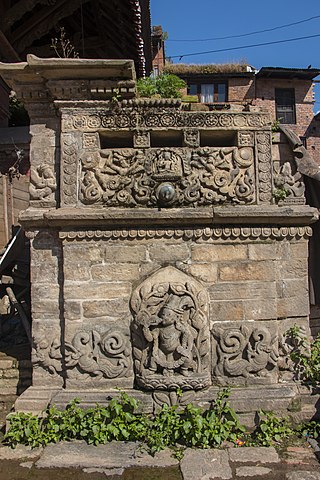
A tutedhara (Nepali) or jahru (Newari) is a traditional drinking fountain found in Nepal. It is a water reservoir built out of stone with a tap that can be opened and closed. These structures are either free-standing or integrated into the wall of another building. They depend on a water well or a dhunge dhara to be filled. Only a few of them are in use today, but some of the stone parts have been put to other uses, and there are contemporary equivalents. The best known tutedhara is the one built into a wall in the royal palace on Kathmandu Durbar Square. It is inscribed with a poem dedicated to the goddess Kali, written in fifteen different languages.

The Tusha Hiti, also known as Royal Bath, is a sunken bath used by the Malla royal family in Nepal. It is at the courtyard of Sundari Chowk, Patan Durbar Square, Lalitpur. King Siddhinarasimha Malla is credited with building the bath in the 17th century. The wall features idols of Ashta Matrikas, eight Bhariavs and Nagas, and the gilt copper spout features idols of Vishnu and Laxmi residing on Garuda. The Tusha Hiti is shaped like a yoni and can be accessed via its main entrance from the western façade.

Juddha Barun Yantra or popularly known as Damkal (Nepali:दमकल) is the oldest fire brigade of Kathmandu, Nepal. Initially, it served for all districts inside the Kathmandu valley - namely Kathmandu, Bhaktapur and Patan and were operated under the Home Ministry with a central office at Newroad, Basantapur. However, with increasing demand, currently, the offices are run separately in each districts. Currently, it operates various fire engines. The refill is done at the nearest water sources or the reservoirs at Mahankal and Jorpati. It has 39 staffs — 11 from the Armed Police Force (APF), 10 from Metropolitan Police and 18 mobilised from the Home Ministry. The fire brigade can be called by dialing 101 from anywhere in Nepal.

Alko Hiti, also known as Alkwo Hiti, Aluko Hiti or Alok Hiti is a 15th-century dhunge dhara in the city of Patan, Nepal. Thanks to the active involvement of the people who rely on this dhunge dhara for their drinking water, Alko Hiti has remained operational from the time it was built to the present day.

Nagbahal Hiti, also known as Elhānani Hiti is an old, presumably 8th-century, dhunge dhara in Nagbahal, a former Buddhist monastery in the city of Patan, Nepal. In spite of efforts to restore this dhunge dhara, the water is no longer used by the majority of people in the area. However, the space is still being used for cultural events.